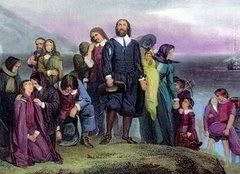Although it appears that the
unified church of the Stockbridge Mohicans reached its peak during the early 1830's, that same church began splitting into factions by the end of that decade. You may remember that
the first permanent split came when the Hendrick and Konkapot faction came into conflict with the tribe's official political leaders as well as with Rev. Cutting Marsh. Eventually
a deal was made which sent the Hendrick and Konkapot faction packing to what is now Kansas.

The next split came only a few years later. Again it happened amidst political turmoil, this time it was the Citizen or "Chicks" party against the Indian or "Quinney" party. Cutting Marsh appears to have tried to remain neutral in that conflict, but the situation proved too tricky for him.
In the spring and summer of 1844 Marsh censured John N. Chicks for "intemperance" (drinking alcohol) and even excommunicated other members of the Citizen party. John's father, Jacob Chicks, a deacon in the church, was insulted by what he felt was unfair treatment of his son. He left Marsh's church to join the Methodists at Brothertown. But the son, John N. Chicks, went farther. He asked Rev. Wesson G. Miller to hold a revival meeting in his father's barn.
 Ethel A. Furman and Associates, were commissioned by the United Methodist Church to create this bronze statue. Clearly the circuit riders' importance is still recognized by the Methodist church today. M
Ethel A. Furman and Associates, were commissioned by the United Methodist Church to create this bronze statue. Clearly the circuit riders' importance is still recognized by the Methodist church today. Miller was a young
Methodist circuit rider who, as a middle-aged man in ill health, wrote a memoir,
Thirty Years in the Itinerancy, which includes an account of what happened next. But first I need to explain that in those days Protestant missionaries had an understanding that they were not to compete with each other. Therefore, Miller understood that John N. Chicks was asking him to step onto Cutting Marsh's turf. Nevertheless, based on what Miller (page 25) was told about Cutting Marsh, he felt that the tribe could use another church.
According to Miller, the worship which he conducted in "Father Chicks" barn was highly successful. My impression is that Miller had a tendency to exaggerate, but nevertheless, the Citizen party's defection to the Methodists was a real split in the Stockbridge church.
The people from the two nations [Stockbridge and Brothertown] came in throngs. The barn was filled, and the groves around it, until my head grew dizzy in looking at the multitudes and thinking of what was to follow... The part borne by Father Chicks, as he was called, the head chief of the Stockbridge nation, also added not a little to the interest of the occasion... his heart was overflowing... Tall and erect in form, with a brow to rule an empire, he rose in the midst of the great assembly and came forward to the stand (page 27).
What followed was a remarkable speech or lay-sermon. Actually, I'll never know which is more remarkable, Jacob Chicks' speech or Miller's description of it:
'Me been a great sinner, as all my people know,' For the moment he could go no further. His noble form shook with emotion, and his manly face was flodded with tears. The whole audience wept with him, for his tears were sublimely eloquent. Recovering himself, he simply added, 'All me want now is to love him, Christ.' Then turning to his people, with a face as radiant as the sunlight, he began to address them in his own language (27-28).
As J.N. Davison pointed out in 1893, Jacob Chicks most likely spoke better English than Miller gives him credit for. Furthermore, Miller estimated Jacob Chicks to be about eighty years-old by then, but he was considerably younger. Nevertheless, saying the man was about eighty set up the next scene. Miller wrote that Chicks became "lithe and animated," and that his non-verbal communication was "enough to move the human soul to the depths of its being." And he goes on:
But to those were added the human voice divine with its matchless cadences, now kindling into a storm of invective, before which his audience shrank, like shriveled leaves in autumn, then sinking to sepulcral tones that seemed to challenge a communion with the dead; now wailing in anguish of sorrow utterly insupportable, and then rising in holy exultation, as one redeemed from sin and inspired with the triumphant shout of victory (page 28).















